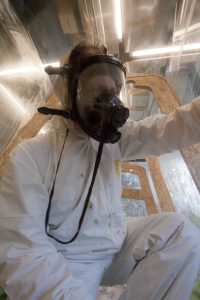Meta.Morf X – Digital Wild / Dokkhuset, March 6 – 7, 2020 / Curator: Zane Cerpina
Adam Zaretsky [us]
Red in Bluetooth and Claw: Bions vrs. Bytes
Can the relations between Bions and Bytes have lasting power, seductive mutualisms, relational integrity even without dignity? Is it data down to the bodily form, the growth of axes, the specialization of the orifices, the orificial economy, the complexity of metabolic syndromes? Is it possible that data is more poetic and less rational, more infectious in a wet charismatic cultishness than dry, cyborgian reductionism of our wilding natures?
Data is encroaching on the flesh, rendering your body and mind into wetware. Is the augmented user experience becoming digital or is the world of data just an extension of smegma and worldly wet mucosal membranes? Is the process of algorithmic colonization a path towards enhancing human utility? Or is this a case of automatic poetry as infectious behavioral and metabolic remodeling? From the big data of Google and Facebook to the big Data of 23 and Me and other bioinformatics searchable databases, Programmers are programming your lifeworld to keep you staid and regime friendly.
But what if we are not all cloistered into Gaussian distributed hyperMicro ‘individuated’ target groups with Click Bait sexual partnerz, Click Bait Politicz and Click Bait Cradle to Grave Economies? What if the cistopia, dystopia of systopia already came with the brains and sinews of poetic misinterpretation? Then the libidinal economy of complete, Non-anonymous, privacy-less Kafkaesque pornography as the spread eagle interface of big data, is not eclipsing free will through Cancel Culture and platform-government-corporate surveillance. No, it is the return of the repressed software engineer’s psyches that has colluded around the dank memic fire of privatization.
In order to reflect on biopolitical flesh resistance, beyond luddute reaction formation, we will look at:
1. Willhelm Reich’s experiments in measuring antifa Bions in Oslo, with the use of tickling and wet towel slapping as orgonomic data points
2. Bioart group Popu Popu collective’s research on Sámi techno-identity in an age of widely available genetic ancestry testing
3. VASTAL (Vivoart School for Transgenic Aesthetics Ltd.) expose on Literary Bioinformatics Studies
4. Lulu and Nana, Genetically Modified Children and the future of choice constructs for anti-aesthetics in designer baby genetic modification.
Is the gory body pod so seeping and untamed? What is this wild flesh that is so in need of data encroachment? And is this data any less wet than the bodies held pronate and irrigated into their genomes as well as into their voice? Isn’t the industrial persuasion engine run by flesh desire and flesh inventions?
Becoming Wild can mean:
1. Becoming Inebriated, Coming on to Drugs.
2. Becoming Feral, raised by non-humans
3. Becoming Guiltless, amoral
4. Becoming Guiltless, immoral
5. Becoming Killer to Survive or for Sport
6. Becoming Sexual, Becoming Swollen
7. Becoming Violent, Rape and Murder
8. Becoming Out of Control, uncontrollable, untamed, untrained
9. Becoming Free
10. Becoming Insane
11. Becoming Non-verbal
12. Becoming Unclean
13. Becoming Honest
Is the body as code a rote programed life cycling for/next loop? The proposition is that life itself as carnage is also wild, irrational and untamable literary splay. Aren’t the data, the subroutines, the software and the platform UX all also already poetry; wet cognitive nuances disguised as lines of code but filthy with baggage, sloughed skin and detritus?
 Adam Zaretsky
Adam Zaretsky
Adam Zaretsky is a Wet-Lab Art Practitioner mixing Ecology, Biotechnology, Non-human Relations, Body Performance and Gastronomy. Zaretsky stages lively, hands-on bioart production labs based on topics such as: foreign species invasion (pure/impure), radical food science (edible/inedible), jazz bioinformatics (code/flesh), tissue culture (undead/semi-alive), transgenic design issues (traits/desires), interactive ethology (person/machine/non-human) and physiology (performance/stress). A former researcher at the MIT department of biology, for the past decade Zaretsky has been teaching an experimental bioart class called VivoArts at: San Francisco State University (SFSU), SymbioticA (UWA), Rensselaer Polytechnic Institute (RPI), University of Leiden’s The Arts and Genomic Centre (TAGC) and with the Waag Society. Adam has also taught DIY-IGM (Do-It-Yourself Inherited Genetic Modification of the Human Genome) at New York University (NYU) and Carnegie Melon University (CMU). He currently runs a public life arts school: VASTAL (The Vivoarts School for Transgenic Aesthetics Ltd.) His art practice focuses on an array of legal, ethical, social and libidinal implications of biotechnological materials and methods with a focus on transgenic humans.





